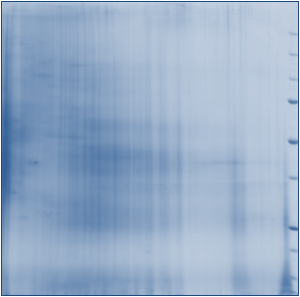Metaproteomics technologies and Methane
Investigating the function of the rumen microbial community and the importance of methane production requires a novel tool that can characterise the whole protein content of a sample, taken at a particular point in time. This technique is known as ‘Metaproteomics’.

Figure 2
The 2D PAGE technique, which was developed for pure cultures, can suffer serious problems with rumen digesta samples. High levels of humic compounds obscure the proteins on the gel or even degrade them completely (Figure 3).

Figure 3
Occasionally, and depending on the sample quality, protein spots can be seen. Proteins are identified by cutting a spot of interest, digesting using trypsin and identifying the peptide sequence using mass spectrometry.
In this gel (Figure 4) from the digesta of a Scottish beef steer, three strongly expressed proteins were identified by mass spectrometry and revealed they were all enzymes involved in methane metabolism.

Figure 4
Shotgun Metaproteomics
‘Next generation’ metaproteomics technologies can produce data without the need for cutting individual spots from a 2D gel. The latest hybrid ion-trap mass spectrometers can separate and analyse samples almost directly from the digested protein extract. The peptides are then reassembled and mapped to a reference database to characterise the metaproteome.
http://planetorbitrap.com/orbitrap-velos-pro#.VRvaC-FFweI
In silico Metaproteomics
It is possible to do rumen metaproteomics without even needing to go into the lab. By working in silico, it is possible to check on the current status of the proteins associated with ruminants by mining the reference databases. Uniprot is a good example that provides a convenient way of carrying out a search. Input the term ‘rumen OR ruminant’ in the search box and over 43000 proteins appear in a list. These can be summarised by taxon giving the relative proportions from the animal, fungi, ciliates, bacteria and methanogenic archaea.
http://www.uniprot.org/
In UniPept, you can get a taxonomy profile from a set of tryptic peptides mapped to the lowest common ancestor (LCA). The result is an interactive chart where you can explore the biodiversity of the sample. The best example is from one of the human gut microbiota samples datasets as this shares many of the microbial species of the rumen.
http://unipept.ugent.be/datasets

